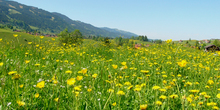Agriculture & Land Management
Our Work
Latest in Agriculture & Land Management
-
Improving environmental financing via result-based agri-environment measures
A new article by IEEP explores the use of result-based agri-environment measures in the region of Baden-Württemberg, Germany. The study shows that result-based schemes can increase the environmental effectiveness and conditionality of the EU Common Agricultural Policy.
-
Result-based agri-environment measures: market-based instruments, incentives or rewards?
Result-based schemes are innovative agri-environment measures, which remunerate farmers only if they can demonstrate to have achieved the desired environmental goal. This is different from ...
-
Whither the new Commission?
IEEP’s David Baldock gives his take on the new Commission in the latest edition of our newsletter. Read about how IEEP is raising ambition for the next EU climate and energy package, plus: priorities and policy options for a circular economy, payments for farmland biodiversity achievements, biodiversity proofing EU spending, and more.
-
High Nature Value farming throughout EU-27 and its financial support under the CAP
This study reviews Member States’ estimates of the extent of HNV farmland and use of RDP measures and the CMEF indicators, then identifies future priorities for CAP support for HNV farming and discusses the support opportunities under the reformed CAP. It offers detailed new evidence about the combined effect of Pillar 1 and Pillar 2 CAP payments on the economic and environmental viability of a typical HNV farming system in three Member States.
-
New report: High Nature Value Farming in the EU
Member States need to make the most of the opportunities under the new Common Agricultural Policy if the declines in HNV farming, critical for meeting our 2020 biodiversity targets, are to be halted.
-
Sectoral resource mobilisation to implement global biodiversity targets
There is an urgent need to find sufficient resources to enable developing countries to implement the global targets for biodiversity by 2020. Financing the conservation and sustainable use of biodiversity from different sectoral funding flows can complement global biodiversity financing.
-
Delivering environmental benefits through entry-level agri-environment schemes in the EU
A new study of the 2007-13 agri-environment schemes across the whole of EU-27 provides the first typology of ‘entry-level’ agri-environment management and environmental objectives, plus a detailed insight into the design of entry-level agri-environment schemes and calculation of payment rates in seven Member States.
Related
-

Debating the Future of The Common Agricultural Policy
The IEEP's platform to share thoughtful commentary and analysis on the future development of European agriculture and rural development policy.
Highlights
-

Result-based agri-environment measures: market-based instruments, incentives or rewards?
Result-based schemes are innovative agri-environment measures, which remunerate farmers only if they can demonstrate to have achieved the desired environmental goal. This is different from ...
